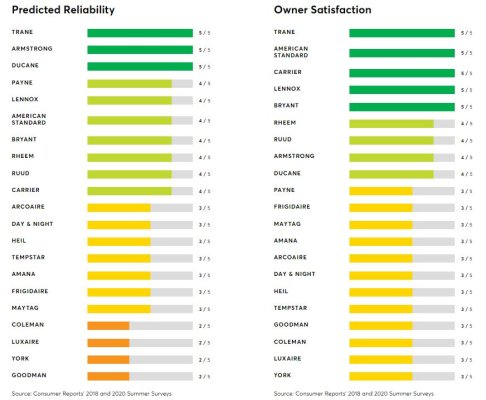80,000 BTU
I'm in Minnesota. My home is a 2-story walk-out. I have 3,000 sq. ft. finished. I want a quieter furnace. I think I'm a candidate for a two stage. What's your opinion?
Currently have an 25 year old Honeywell programmable. I would likely get a new smart thermostat and let it run the furnace.
Not sure what a hot vent stack is but currently my furnace vents via PVC piping out the side of the house.
First, a two stage will have a 2 speed inducer fan, and variable speed blower. this may be quieter if it runs longer on lower speed/burners. Properly sized air flow/velocity will run quieter even if its a single stage. Not sure if it would be worth it unless you had a larger BTU model that would need to run on low stage for longer. It sounds like in your climate an 80K BTU furnace is the minimum for a fully sealed 3000 sqft home (off the top of my head thinking). You need to calculate the CFM required and set your blower CFM on a variable unit. Allow 130 CFM per vent register. I suspect you have some shut off and the noise is due to high flow in the ducts? 15 -4x10 vents would be 1950 cfm at the blower, which is about what a 80K BTU furnace will run at with gas and duct temp at 110F+
A two stage variable 80K 21 inch cabinet upflow furnace should cost <$2000 plus install. I would not add any coil to the furnace, install one if you must separately for AC. I would definitely shop this down in your area or buy one after getting install only bids. Some guys like to pick up side jobs on weekends, and for this replacement job, I bet you could get qualified labor through Angies List or Craigs List with caution to check references.
Hot vent is a term for a metal double wall chimney vent. Lower efficiency furnaces have hot exhaust. If you only have a PVC vent, then min efficiency 92% would be best, but then you get the condensate issue.
Buy an Ecobee thermostat, super easy to install and config. About $150 at HD or Costco etc. Set up for a two stage furnace is driven by the wiring and easy programming. Hopefully you have extra wires at the stat to configure the second stage and AC wiring.
A lot of mumbo jumbo in specifying the HX. Get real material specs, or tell them to shove off. Like I said, a lot of mfg offer the primary HX in aluminized steel, which is basically a coated mild steel, nothing to do with alloy or stainless materials. When they say aluminum fin over SS tube, ask what SS. If it is simple austenitic 304, it ain't going to last, like I say, a min would be 316 or better some grade of duplex SS. If its welded I would want specific details, most are not due to high temp stress corrosion cracking in the weld zones.
For the outrageous price you are being quoted, I would want better detail than some made up super steel name.

